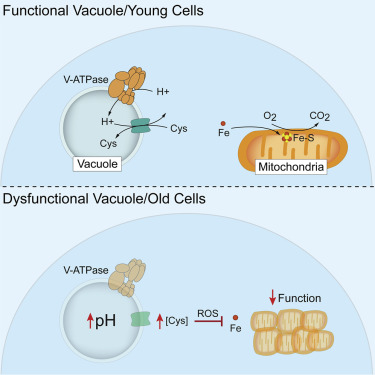Our official English website, www.x-mol.net, welcomes your
feedback! (Note: you will need to create a separate account there.)
Cysteine Toxicity Drives Age-Related Mitochondrial Decline by Altering Iron Homeostasis.
Cell ( IF 45.5 ) Pub Date : 2020-01-23 , DOI: 10.1016/j.cell.2019.12.035 Casey E Hughes 1 , Troy K Coody 1 , Mi-Young Jeong 2 , Jordan A Berg 1 , Dennis R Winge 2 , Adam L Hughes 1
Cell ( IF 45.5 ) Pub Date : 2020-01-23 , DOI: 10.1016/j.cell.2019.12.035 Casey E Hughes 1 , Troy K Coody 1 , Mi-Young Jeong 2 , Jordan A Berg 1 , Dennis R Winge 2 , Adam L Hughes 1
Affiliation

|
Mitochondria and lysosomes are functionally linked, and their interdependent decline is a hallmark of aging and disease. Despite the long-standing connection between these organelles, the function(s) of lysosomes required to sustain mitochondrial health remains unclear. Here, working in yeast, we show that the lysosome-like vacuole maintains mitochondrial respiration by spatially compartmentalizing amino acids. Defects in vacuole function result in a breakdown in intracellular amino acid homeostasis, which drives age-related mitochondrial decline. Among amino acids, we find that cysteine is most toxic for mitochondria and show that elevated non-vacuolar cysteine impairs mitochondrial respiration by limiting intracellular iron availability through an oxidant-based mechanism. Cysteine depletion or iron supplementation restores mitochondrial health in vacuole-impaired cells and prevents mitochondrial decline during aging. These results demonstrate that cysteine toxicity is a major driver of age-related mitochondrial deterioration and identify vacuolar amino acid compartmentation as a cellular strategy to minimize amino acid toxicity.
中文翻译:

半胱氨酸毒性通过改变铁稳态来驱动与年龄相关的线粒体衰退。
线粒体和溶酶体在功能上是相关的,它们相互依赖的衰退是衰老和疾病的标志。尽管这些细胞器之间存在长期的联系,但维持线粒体健康所需的溶酶体的功能仍不清楚。在这里,我们在酵母中进行研究,表明溶酶体样液泡通过空间分隔氨基酸来维持线粒体呼吸。液泡功能缺陷导致细胞内氨基酸稳态破坏,从而导致与年龄相关的线粒体衰退。在氨基酸中,我们发现半胱氨酸对线粒体的毒性最大,并表明非液泡半胱氨酸升高会通过基于氧化剂的机制限制细胞内铁的可用性,从而损害线粒体呼吸。半胱氨酸消耗或铁补充剂可恢复液泡受损细胞中的线粒体健康,并防止衰老过程中线粒体衰退。这些结果表明,半胱氨酸毒性是与年龄相关的线粒体退化的主要驱动因素,并将液泡氨基酸区室确定为最小化氨基酸毒性的细胞策略。
更新日期:2020-01-23
中文翻译:

半胱氨酸毒性通过改变铁稳态来驱动与年龄相关的线粒体衰退。
线粒体和溶酶体在功能上是相关的,它们相互依赖的衰退是衰老和疾病的标志。尽管这些细胞器之间存在长期的联系,但维持线粒体健康所需的溶酶体的功能仍不清楚。在这里,我们在酵母中进行研究,表明溶酶体样液泡通过空间分隔氨基酸来维持线粒体呼吸。液泡功能缺陷导致细胞内氨基酸稳态破坏,从而导致与年龄相关的线粒体衰退。在氨基酸中,我们发现半胱氨酸对线粒体的毒性最大,并表明非液泡半胱氨酸升高会通过基于氧化剂的机制限制细胞内铁的可用性,从而损害线粒体呼吸。半胱氨酸消耗或铁补充剂可恢复液泡受损细胞中的线粒体健康,并防止衰老过程中线粒体衰退。这些结果表明,半胱氨酸毒性是与年龄相关的线粒体退化的主要驱动因素,并将液泡氨基酸区室确定为最小化氨基酸毒性的细胞策略。










































 京公网安备 11010802027423号
京公网安备 11010802027423号